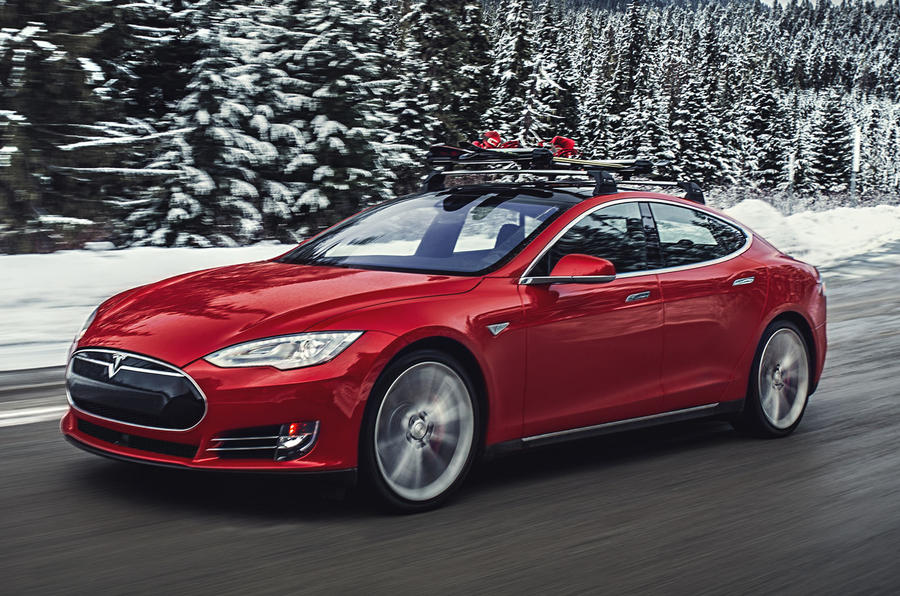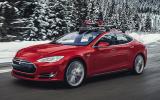What is it?
The Tesla Model S has already wowed us in conventional form - if, indeed, the rear-wheel-drive, fully electric family hatchback could ever be called ordinary. Described in its full Autocar road test as "practical, refined and desirable - a triumph", the Model S has been available so far in a couple of guises: the regular 85, with 376bhp and a range of 310 miles, and the more modest 60, which has a smaller battery and a reduced range of 240 miles.
The P85D is something else altogether. Instead of a single electric motor driving the rear wheels, it gets one on each axle to run in four-wheel drive - and the upgrades don't stop there. The rear-mounted motor gets Tesla's Performance designation (the 'P' in the model name), raising it to 464bhp, and with the front wheels offering an additional 218bhp, you suddenly end up with an entirely respectable-looking five or seven-seat family hatchback, with a combined output of 682bhp and 687lb ft.
The resulting performance figures are pretty staggering. The top speed is a run-of-the-mill 155mph, but 0-60mph is claimed to take just 3.2sec. Let's think about that for a moment: that's the same time, to the tenth, as the official Autocar benchmark for the Ferrari 458 Speciale (the regular Italia is 0.1sec slower). It has the potential to make the P85D's list price of £79,080 look a bit of a bargain - especially when you consider that free access to Supercharging - Tesla's ever-expanding network of quick charging points - is included as standard.
Nor should P85D users be any more susceptible to range anxiety than owners of more conventional Model S editions. Tesla claims that the car's digital power controls can utilise two motors more effectively than one - so there's actually a modest gain in range over the old rear-drive P85. It's now 300 miles, just 10 miles shy of the regular 85.
Incidentally, the new model sits on top of a revised range, where the twin-motor four-wheel drive set-up (identified by the 'D' suffix) is also available as a £4100 upgrade to the regular 85. That edition gets a regular 50/50 power split between front and rear axles, though, with the same combined output as the 85. In the meantime, Tesla has quietly dropped the rear-drive P85 from the line-up; its reasoning is that anyone who wants the extra grunt will be happy to pay for the four-wheel-drive model that can make better use of it.



















Join the debate
Add your comment
Not that impressive
We see all these drag races against sports cars which Tesla wins (I've seen only one car using it's LC or even reving the engine before start). They just sit there on idle when the drag race starts.
So, don't use that power too much or you burn your Tesla. And some of you are correct, most Tesla owners also have a second and third car, often high performance German cars.
Goverment Stats
Fact Germany (shows what can be done even with none or very little coastline) - In 2012, all renewable energy accounted for 21.9% of electricity, with wind turbines and photovoltaic providing 11.9% of the total. And that was a couple of years ago.
Fact is renewable energy sources are going and you can't stop it. If you don't believe look out to sea and see wind turbines or look up and see Solar panels on roofs.
@xxxx
Norma Smellons wrote:Fact - 5
Your facts are old, the world is changing fast. In January this year wind power accounted for 14% of the UK's electricity supply. A wind farm with a capacity of 2.4GW has just been approved off Dogger Bank, will be the UK's second biggest supplier of electric second only to Drax. Renewable energy in Scotland is it's biggest source of energy, more than nuke, coal and gas.
The arabs and russian oligarchs of the world love people like yourself with the defeatist attitude as it ensures they continue to live like kings while we drive around in 4 cylinder diesel misery. I'd take a Tesla any day of the week over that that.
Norma Smellons wrote:
Seems like you're 'Facts' didn't really bear out did they?!
In the second quarter of 2018 the percentage of renewables was 28.1%. Still some time to fo till 2020 too!